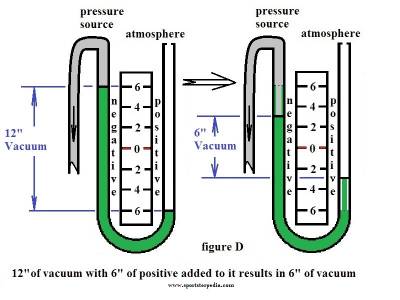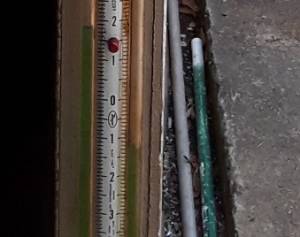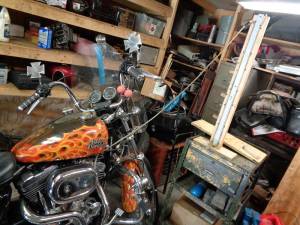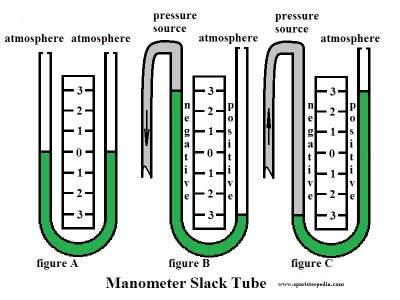Table of Contents
REF: Tools - 173
Manometer (slack tube) for Measuring Air Pressure
What is a manometer?
See also in the Sportsterpedia:
A manometer is used to measure the pressure difference between two gases, often atmosphere and the gas being tested. 1)
A typical U-tube manometer consists of a U-shaped tube half filled with liquid.
The liquid is typically either mercury or water (colored with food coloring for more contrast and easier reading).
The long sides of the tube have a measuring scale marked off in inches or millimeters.
When a gas / air source line is connected to one side of the manometer, the height of the liquid shifts.
The difference in the height of the liquid in each side is used to calculate the source pressure.
What is it used for?
There are many purposes for a manometer in diagnosing Motorcycle issues;
- A manometer has long been a tool to help in synchronizing the vacuum between multi-carb engines.
With a Sportster having only the one carb, the meter can still be used to measure how much vacuum is present in the venture. - Measuring crankcase pressure
- Measuring breather vent(s) opening pressure
- Measuring primary compartment pressure
- Flow bench testing on heads
- Calibrating pressure gauges
Where to get one
A simple U-tube manometer can be homemade or bought commercially.
Dwyer is a popular brand and these can also be purchased used (Ebay) at a lower price.
Most of the Dwyer tubes have some check valves in the plastic block up top that are supposed to keep them from loosing liquid if the draft changes suddenly. 2)
These check valves have a cork float and a couple of other items that tend to get gunked up and they can make the tube almost impossible to fill.
Many folks strip out the valves and drain the tubes when they are not using them.
The difference in elevation between the two liquid levels is the draft.
You can also buy digital ones with varying degrees of resolution and accuracy.
Here is a 36" Digital Manometer with tubing from Home Depot for $120 (range 0-5 psi, resolution of 0.003 psi and ±0.3% accuracy).
Here is another 36 in. Digital Manometer with tubing for $170 (range of 0-100 psi and a resolution of 0.1 psi)
Crankcase pressure should never reach more than +5 psi either positive or negative.
The higher rated instrument will measure a larger range of differential pressure but you'll lose accuracy measuring the lower pressure from a Sportster crankcase.
The simple U-tube manometer has been noted as the most accurate for this application although the accuracy is in your eyes and hands.
It's simple in construction, low cost, very accurate and sensitive and it can be used to measure other process variables. 5)
However, the drawbacks include fragile construction, high sensitivity to temperature changes and errors can happen while measuring the liquid height.
A simple manometer can be built by partially filling a clear plastic tube with a colored liquid to allow the fluid level to be easily observed (see link above).
The tube is then bent into a U-shape and fixed in an upright position.
The levels of the fluid in the two vertical columns should be equal at this point, as they are currently exposed to the same pressure.
This level is therefore marked and identified as the zero reference point of the manometer.
How does it work?
With the U-tube design, one long tube is mounted vertically on a stand, curved at the bottom center which creates two 'legs' vertically positioned.
This leaves both ends open to atmosphere with the air above the water level having equal pressure in both legs.
One side of the tube is then connected to the pressure source being tested and the other leg is left open to atmosphere.
Once the pressure source is activated, the water moves up or down in each leg indicating where the pressure is headed and the how much.
If the pressure is different between the two ends of the tube, the liquid will move away from the source of greater pressure. 6)
In the drawing to the right, the slack tube represents conditions of atmospheric pressure, then with vacuum and positive pressure applied to the tube. 7)
(figure A)
With both legs of the tube open to the atmosphere (or subjected to the same pressure), the liquid maintains the same level in each leg, establishing a zero reference. 8)
(figure B)
With a negative pressure (vacuum) applied to the left side of tube, the liquid rises in the left leg and lowers respectively in the right leg.
(figure C)
As more positive pressure is applied to the negative in the left side of tube, the liquid lowers in the left leg and rises respectively in the right leg.
The engine crankcase pressure cycle begins with the downstroke pushing positive pressure out of the crankcase breather valve(s).
Then on the next upstroke, the breather(s) close and negative pressure builds in the crankcase.
In a perfect world, the same but opposite pressure is then applied during the next downstroke.
However, due to piston ring blowby and other air intake sources, there will be instances where more positive pressure is created.
The increasing positive pressure lowers the total of the negative pressure coming from the source and the tube reflects those changes in pressure.
 Example (figure D):
A rise in vacuum pressure of 6“ of water (left leg) has a total of 12” in rise as the water has traveled in both legs.
Example (figure D):
A rise in vacuum pressure of 6“ of water (left leg) has a total of 12” in rise as the water has traveled in both legs.
Then a rise in the positive leg of 3“ (6” in actual height) on downstroke still yields a balance of 6“ of vacuum from the engine (showing 3” on left leg).
In this example, the total pressure in the crankcase is still negative but with not as much pressure as was before the last upstroke.
The liquid in the tube may fluctuate slightly with the push-pull of crankcase pressure at cold startup and at hot idle.
The fluctuations should decrease as engine speed rises due to the shorter reaction time of the faster moving pistons.
Until the liquid in the right leg rises above the initial starting point (O reference), the total pressure in the tube exerted out of the engine is still negative even though the pulsations are still present.



